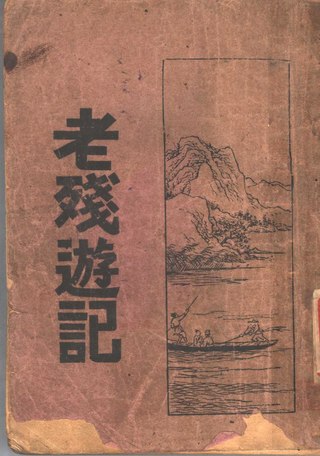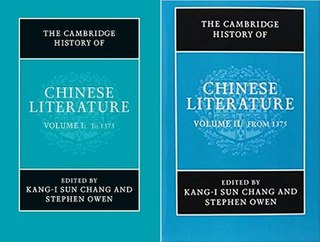Related Research Articles
The history of Chinese literature extends thousands of years, and begins with the earliest recorded inscriptions, court archives, building to the major works of philosophy and history written during the Axial Age. The Han and Tang dynasties were considered golden ages of poetry, while the Song (960–1279) and Yuan (1271–1368) were notable for their lyrics (ci), essays, dramas, and plays. During the Ming and Qing, mature novels were written in written vernacular Chinese, an evolution from the preeminence of Literary Chinese patterned off the language of the Chinese classics. The introduction of widespread woodblock printing during the Tang and the invention of movable type printing by Bi Sheng (990–1051) during the Song rapidly spread written knowledge throughout China. Around the turn of the 20th century, the author Lu Xun (1881–1936) is considered an influential voice of vernacular Chinese literature.
Genre fiction, also known as formula fiction or popular fiction, is a term used in the book-trade for fictional works written with the intent of fitting into a specific literary genre in order to appeal to readers and fans already familiar with that genre.

Jin Ping Mei —translated into English as The Plum in the Golden Vase or The Golden Lotus—is a Chinese novel of manners composed in vernacular Chinese during the latter half of the 16th century during the late Ming dynasty (1368–1644). Consisting of 100 chapters, it was published under the pseudonym Lanling Xiaoxiao Sheng (蘭陵笑笑生), "The Scoffing Scholar of Lanling," but the only clue to the actual identity is that the author hailed from Lanling County in present-day Shandong. The novel circulated in manuscript as early as 1596, and may have undergone revision up to its first printed edition in 1610. The most widely read recension, edited and published with commentaries by Zhang Zhupo in 1695, deleted or rewrote passages to help understand the author's intentions.

Literary fiction, mainstream fiction, non-genre fiction, serious fiction, high literature, artistic literature, and sometimes just literature, are labels that, in the book trade, refer to market novels that do not fit neatly into an established genre or, otherwise, refer to novels that are character-driven rather than plot-driven, examine the human condition, use language in an experimental or poetic fashion, or are simply considered serious art.

Classic Chinese Novels are the best-known works of literary fiction across pre-modern Chinese literature. The group usually includes the following works: Ming dynasty novels Romance of the Three Kingdoms, Water Margin, Journey to the West, and The Plum in the Golden Vase; and Qing dynasty novels Dream of the Red Chamber and The Scholars.
Victor Henry Mair is an American sinologist currently serving as a professor of Chinese at the University of Pennsylvania. Among other accomplishments, Mair has edited the standard Columbia History of Chinese Literature and the Columbia Anthology of Traditional Chinese Literature. Mair is the series editor of the Cambria Sinophone World Series, and his book coauthored with Miriam Robbins Dexter, Sacred Display: Divine and Magical Female Figures of Eurasia, won the Sarasvati Award for the Best Nonfiction Book in Women and Mythology.
David Der-wei Wang is a literary historian, critic, and the Edward C. Henderson Professor of Chinese Literature at Harvard University. He has written extensively on post-late Qing Chinese fiction, comparative literary theory, colonial and modern Taiwanese literature, diasporic literature, Chinese Malay literature, Sinophone literature, and Chinese intellectuals and artists in the 20th century. His notions such as "repressed modernities", "post-loyalism", and "modern lyrical tradition" are instrumental and widely discussed in the field of Chinese literary studies.

Literature is any collection of written work, but it is also used more narrowly for writings specifically considered to be an art form, especially novels, plays, and poems. It includes both print and digital writing. In recent centuries, the definition has expanded to include oral literature, much of which has been transcribed. Literature is a method of recording, preserving, and transmitting knowledge and entertainment. It can also have a social, psychological, spiritual, or political role.
A novel is an extended work of narrative fiction usually written in prose and published as a book. The word derives from the Italian: novella for "new", "news", or "short story ", itself from the Latin: novella, a singular noun use of the neuter plural of novellus, diminutive of novus, meaning "new". According to Margaret Doody, the novel has "a continuous and comprehensive history of about two thousand years", with its origins in the Ancient Greek and Roman novel, Medieval Chivalric romance, and the tradition of the Italian Renaissance novella. The ancient romance form was revived by Romanticism, in the historical romances of Walter Scott and the Gothic novel. Some novelists, including Nathaniel Hawthorne, Herman Melville, Ann Radcliffe, and John Cowper Powys, preferred the term "romance". Such "romances" should not be confused with the genre fiction romance novel, which focuses on romantic love. M. H. Abrams and Walter Scott have argued that a novel is a fiction narrative that displays a realistic depiction of the state of a society, while the romance encompasses any fictitious narrative that emphasizes marvellous or uncommon incidents. Works of fiction that include marvellous or uncommon incidents are also commonly called novels, including Mary Shelley's Frankenstein, J. R. R. Tolkien's The Lord of the Rings, and Harper Lee's To Kill a Mockingbird.

The Travels of Lao Can is a novel by Liu E (1857–1909), written between 1903 and 1904 and published in 1907 to wide acclaim. Thinly disguising his own views in those of Lao Can, the physician hero, Liu describes the rise of the Boxers in the countryside, the decay of the Yellow River control system, and the hypocritical incompetence of the bureaucracy. Its social satire showed the limits of the old elite and officialdom and gave an in-depth look into everyday life in the countryside in the late Qing period.

Bianwen refers to a literary form that is believed to be some of the earliest examples of vernacular and prosimetric narratives in Chinese literature. These texts date back to the Tang dynasty (618–907) and Five Dynasties (907–960) periods, and were first discovered among a cache of manuscripts at Dunhuang, Gansu Province, China in the early twentieth century.

A Flower in a Sinful Sea is a novel by Jin Tianhe and Zeng Pu. First published in serial installments beginning in 1904, the work is a roman à clef. The work was partially translated to English by Rafe de Crespigny and Liu Ts'un-yan in 1982. It was also translated to French and Russian.

Zeng Pu was a Chinese novelist.

Wenming Xiaoshi, translated into English as Modern Times, is a novel by Li Baojia. The novel is a satire of pseudo-reformers in the Qing Dynasty period who found difficulty adjusting to modernization, including its complexities and problems. The novel consist of 60 chapters. It has often been compared to Li's other novel Officialdom Unmasked. From 1903 to 1905 the work was serialized in Fiction Illustrated. The first edition of the entire work was published in 1906. Douglas Lancashire published an English translation, titled "Modern Times," in 1996.
The Columbia Anthology of Modern Chinese Literature is a 1995 anthology of Chinese literature edited by Joseph S. M. Lau and Howard Goldblatt and published by Columbia University. Its intended use is to be a textbook.
The Columbia Anthology of Chinese Folk and Popular Literature is a 2011 book edited by Victor H. Mair and Mark Bender and published by the Columbia University Press.

The Cambridge History of Chinese Literature is a 2-volume history book series published by Cambridge University Press in 2013. The books were edited by Kang-i Sun Chang and Stephen Owen. Volume 1 deals with Chinese literature before the Ming dynasty, and Volume 2 from the Ming dynasty onward.
Zong-qi Cai (蔡宗齊) is a bicultural U.S./China academic based at the University of Illinois at Urbana-Champaign, where he teaches Chinese literature and Classical Chinese poetry and leads the Forum on Chinese Poetic Culture. Cai also teaches as the Lee Wing Tat Chair Professor of Chinese Literature at Lingnan University. Widely published in both English and Chinese, Prof. Cai puts equal emphasis on individual research, collective contributions and the development of a mutually beneficial East-West literary academic culture. Cai edits the Columbia University Press series How to Read Chinese Literature as well as the Brill book series Chinese Texts in the World, the Journal of Chinese Literature and Culture, Prism: Theory and Modern Chinese Literature, and Lingnan Journal of Chinese Studies.
Zhongguo Wenxue Shi is a book about the history of Chinese literature by Lin Chuanjia, published in 1904. It was the first known published history of Chinese literature in Chinese.

Douglas Mark Underwood is an American journalist and media studies scholar. He is a Professor of Communication at the University of Washington.
References
- Dean, Kitty Chen (Nassau Community College). "The Columbia History of Chinese Literature" (book review). Library Journal , ISSN 0363-0277, July 1, 2001. Volume 126, Issue 12, p. 89.
- Fuehrer, Bernhard. "The Columbia History of Chinese Literature" (book review). The China Quarterly , ISSN 0305-7410, 06/2004, Issue 178, pp. 535 – 536. Available from HeinOnline.
- Mather, Richard B. (University of Minnesota). "The Columbia History of Chinese Literature" (book review). Journal of the American Oriental Society , ISSN 0003-0279, 01/2003, Volume 123, Issue 1, pp. 234 – 235. Available from JSTOR. - DOI 10.2307/3217874